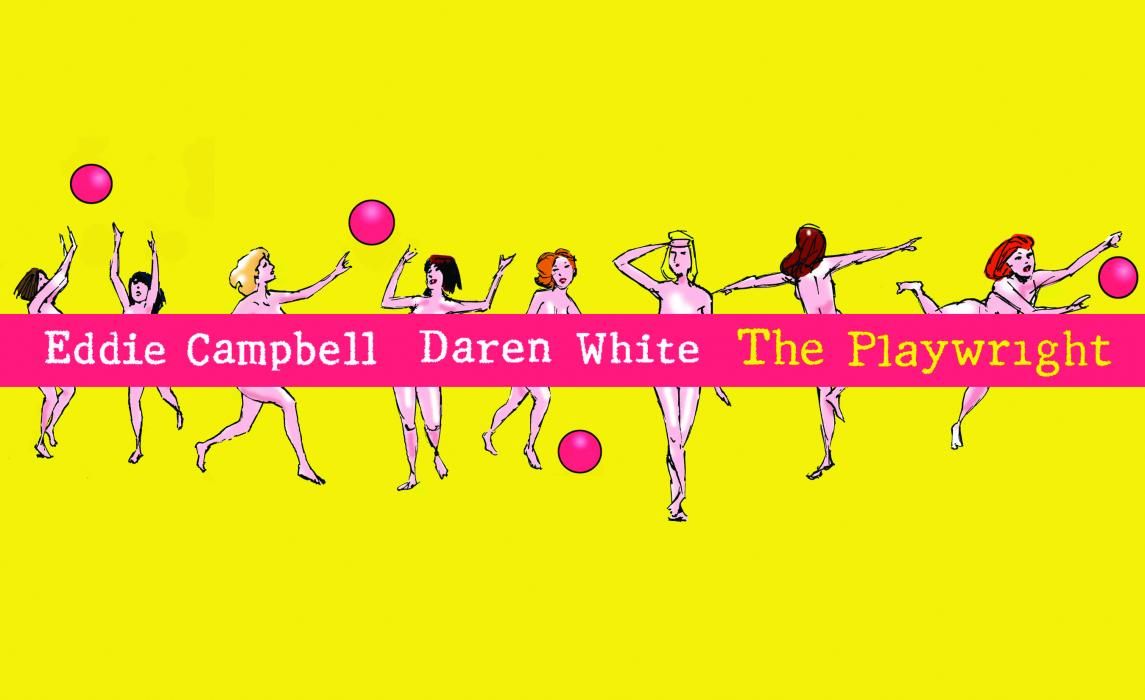Originally partially serialized in the anthology "DeeVee," "The Playwright" follows an unnamed playwright (referred to only as "The Playwright") as he goes through his daily life, wallowing in loneliness and self-pity but producing fantastic works that win him critical acclaim and awards. The pacing goes in starts and stops, sometimes spending a long period of time on one moment before jumping all around on tangential paths to give us a strong concept of the Playwright's life, and also the context into which he fits with other characters. Even though it seems like there isn't a strict narrative plot, one exists and the payoff is something that all tortured artists fears, and is gotten to with such subtlety that it sneaks up on the reader.
The first thing I noticed in "The Playwright" is the page layouts. On each page are three panels with narrative text just above them. While this layout is played with at times by decreasing the number of panels or moving a narrative caption into the panel, this is the manner in which the comic is presented most often. Immediately, there's a sense of reading a series of comic strips, but that passes quickly with the lack of punchlines and smooth flow of narrative. White's narration is done in the third-person, giving the work a sense of distance that, coupled with the protagonist being referred to as The Playwright, immediately lends a sense of importance to the character. He must be worth noticing because he's not just a playwright, he's The Playwright, and we're spending so much time with him.
At the beginning, his days are spent watching women, writing, having tea with the man who he rents a room from, and, when he finally gets a computer, trolling the internet for pornography. There's a sense of sadness and loneliness about the character. He comes off as somewhat pathetic: the artist that observes life, longs to be a part of it, but has resigned himself to merely recording his observations. Judging from every work of his mentioned being 'award-winning,' he's quite successful, but he doesn't seem happy or content. He simply is.
One of The Playwright's chief obsessions and concerns is sex. Much of the book revolves around with his obsessing over women, studying them, while also being too timid and intimidated to do anything about it. An early story in the book has him visiting a prostitute only to not be able to perform when he thinks of all of the men she's no doubt had sex with, while, later in the book, he meets a woman on holidays who is a big fan of his, but he spurns her advances after he overhears another man bragging that she offered to perform oral sex on him. Even the eventual relationship that The Playwright enters is done through passive means. He takes very little action to gain the favor or attention of women, often chickening out after taking the initial steps.
Paired with White is Eddie Campbell, providing the art and lettering that gives the book such a strong visual style. Campbell uses a lot of repeating panels in his art, but does so not by simply reproducing a previous panel, he crops and zooms for a differing effect. In the preview pages showing The Playwright on the bus, he does this extensively for both The Playwright and the woman he's watching, drawing the focus in on specific parts of each of them to create tension and provide visual cues that play off the writing. You can also see his habit of starting a page with a panel that's either shorter or taller than the others, creating an ascending or descending pattern as you read across the page, giving a sense of journeying through The Playwright's life.
Campbell's use of watercolors instead of black and white or another form of coloring add to that idea that we're reading about an important man's life that plays with the mundane details of his life. Watercolors give a sense of refinement and 'culture' to the book, while also showing off Campbell's skill with paints. He sticks to realist renderings of what happens, but also use the paints at times to make certain images stand out or jump off the page because of bright, vibrant colors. His art style, itself, is realistic in its distanced observance of what's happening, but he uses that style to also highlight the grotesqueness of the world when he zooms in on a previous panel, turning his thinner lines into big, thick black slabs of ink that are rougher and messier. He uses the zooms to great effect, punctuating scenes with these harsher versions of art we've already seen.
Together, White and Campbell give us a window into the life and world of The Playwright, a man who creates great works of art, but doesn't actually participate in life. Despite the distance in the narration, there's a great emotional impact as the book progresses, underscored by Campbell's art. "The Playwright" is a touching and masterful work that is definitely one of the 'must own' graphic novels of 2010.

